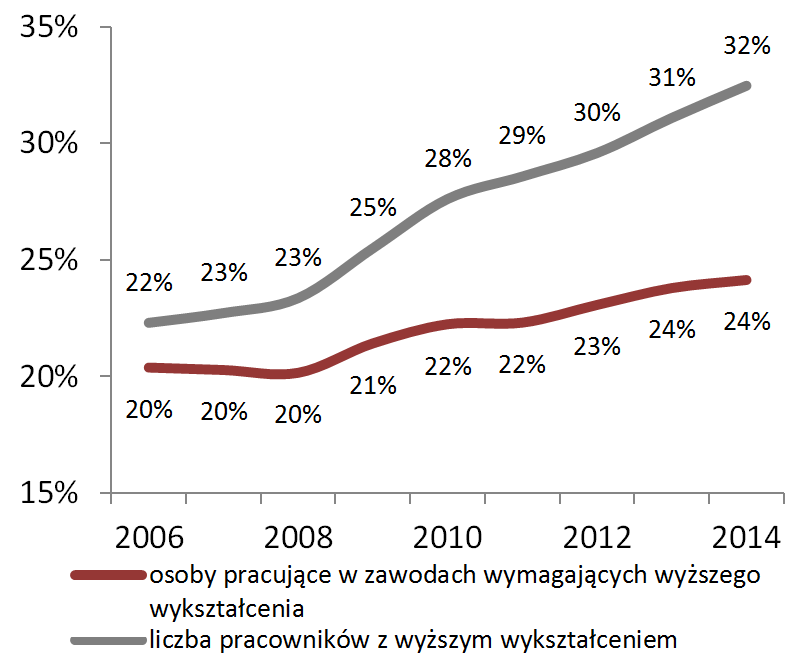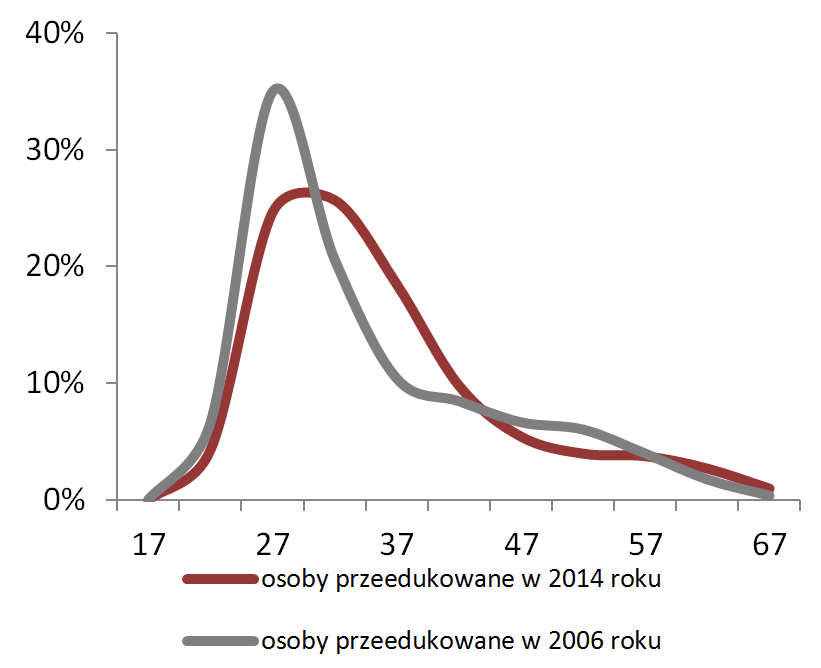Jan Baran
Poland, as other CEE countries, has experienced a very strong increase in university enrollment. In the early 1990s, 11% of young Poles entered university. Now this number is over four times higher. However, young graduates face difficulties to enter the labour market and they often tend to work in jobs not corresponding to their education. Thus it suggests rising educational mismatch taking place.
In this brief analysis we look at changes in overeducation in Poland over 2006-2014. The essential assumption behind this analysis is that each occupation can be assigned a required education level. We split jobs into ‘university jobs’ and ‘non-university jobs’ using Polish employers’ responses which education level is required for vacating positions.[1] Then we combine this information with Labour Force Survey data to find how many people worked in jobs not matching their education. Although there are many studies identifying extent of overeducation,[2] most of them look at one moment of time and there is little evidence on changes over time.
In 2006 the university jobs accounted for 20.4% of total employment, whilst in 2014 they accounted for 24.1% (see Fig 1). It means newly created 860 thousand jobs. At the same time number of tertiary-educated workers rose by 1.90 mln individuals. Thus, the surge in number of tertiary educated workers significantly outpaced the changes in the demand side of the labour market. The fastest increase in the number of tertiary graduates was observed mainly among technicians and associate professionals, and clerical support workers. Those occupations require only middle-level skills. It means that as number of tertiary graduates grow, the prevalence of higher qualification moves down in job distribution. Nevertheless, there are no signs of severe mismatch: we do not observe more university graduates being employed in elementary occupations.
As a result, the incidence of overeducation steadily increased over the analysed period. In 2006 the share of workers identified as overeducated in total employment was 6.7% (980 thousand people). In 2014 they accounted for 12.0% of total employment (1.9 mln people).[3] The risk of being overeducated rose as well. In 2006, 30% of tertiary educated workers worked in non-university jobs, whilst in 2014 it was 37%.
Figure 1. University jobs and share of tertiary educated workers in total employment, 2006-2014.

Sours: Author’s own elaboration based on LFS and BKL data.
Figure 2. Age distribution of overeducated individuals 2006 and 2014

Sours: Author’s own elaboration based on LFS and BKL data.
The overeducated individuals are usually young, at the beginning of their job careers. The average length of job tenure in current workplace for overeducated individuals is 7.2 years, compared to 10.8 years of matched tertiary educated individuals. Low tenure is associated with lower age of overeducated individuals: 55% of overeducated individuals are aged less than 35. However, we see that age distribution moves rightwards (see Fig 2), meaning that overeducation starts affecting also workers in the middle of their job careers.
Overeducated individuals are remunerated less than those with matched tertiary education (the average wage difference of 33%). However they earn more than non-tertiary educated workers in non-university jobs (the difference of 24%). It suggests that overeducation is associated with wage penalty compared to matched graduates but it gives wage premium when compared to non-tertiary educated individuals in non-university jobs.
To conclude, Poland is an example of country that experienced immense education boom, but the demand for higher qualifications lagged behind. It caused many university graduates taking job in middle-skill occupations such as support clerical jobs. The speed of rising education mismatch is worrisome. Our analysis suggests that number of overeducated people almost doubled between 2006-2014. Moreover, the overeducation seems no longer affecting only young individuals, but there is also rising number of overeducated ones in their 30s.
[1] To identify university jobs we use Balance of Human Capital survey (Bilans Kapitalu Ludzkiego, BKL). BKL survey, the employer is asked which level of education is required for candidates for recently vacating positions. For each job (2-digit ISCO codes) we obtain the frequency of declarations that tertiary education is required. The occupation is named a university job when this frequency exceeds some threshold value. We choose 70% threshold, but some other threshold value can be chosen instead.
[2] See Flisi et al. (2014) [https://ec.europa.eu/jrc/en/publication/eur-scientific-and-technical-research-reports/occupational-mismatch-europe-understanding-overeducation-and-overskilling-policy-making] for an extensive comparison of different measures of educational mismatch for EU member states.
[3] Choosing different threshold changes the values, but the increasing pattern of overeducation incidence is maintained. For example, if we use a 50% threshold to identify the university jobs, we obtain overeducation levels of 5.5% in 2006 and 9.9% in 2014, respectively.

